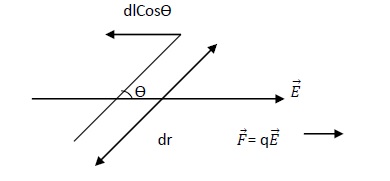Potential Difference - Relation with Electric Field
Description:
To understand the relation between the potential difference and the electric field, take two points A and B in the electric field with a very small distance (dr) between them. There exists some potential difference between these two points and If a charge’q’ is placed at point B and move it to A, some amount of work will have to be done. So the displacement of charge will be in the direction opposite to the direction of electric field. So, the angle between force on charge and the displacement of charge is 180o.

Due to work done on charge, charge will experience some amount of force. Since the distance between the points A and B tends to zero, the force experienced by the charge will be same at both the points.
At point ‘B’ Force on charge q = q E
At point ‘A’ Force on charge q = q E
With changing force, it is not possible to get a unit value of Work at every point . Since the force is same at A and B so, Work done on charge ‘q’ = Force * displacement.
The potential difference between two points A and B Will be −
VA - VB = dV = V = VAB = WABq
VAB = Force * displacement.cosθ q
Here θ = 180o
So, VAB = F∗ dr cos180q
VAB = -Fdrq
= -q E drq
VAB = -E dr (dr is the path length.)
So, dV = -E dr
Or, -dVdr = E.
This equation gives the relation between E and dV. Negative sign shows that potential difference decreases in the direction of electric field.
Special case
To calculate the work done by the charge when it is moved from point B to A making an angle θ with electric field, divide the displacement vector dl into two components dl cosθ and dl sinθ. As shown in figure. The direction of Force is along Electric field and the displacement component dlcosθ is against the direction of Force. So, the angle between force on charge and the displacement of charge is 180o.

So, dV = -E drcosθ
So, -dVdr = Ecosθ
⇒ Ecosθ = -dVdr
Another unit for electric field −
Since, E = - dV/ dr
⇒ Unit of E = volt/meter = Vm-1

